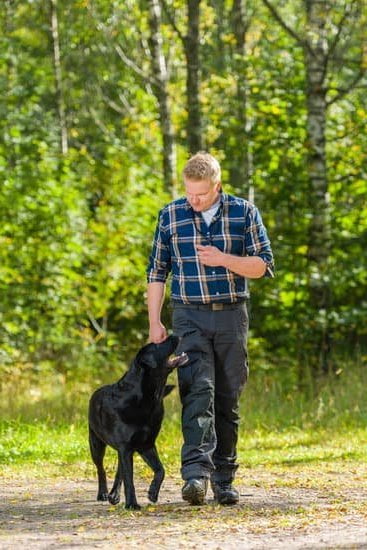As pet owners, we all want our furry friends to have the best possible quality of life. One important aspect of their well-being that is often overlooked is their sleeping habits. Just like humans, dogs need proper rest and sleep in order to stay healthy and happy. In this article, we will discuss how to train your dog to sleep in a dog bed, a step-by-step process that can help improve their sleep quality and overall behavior.
Having a designated dog bed for your furry companion comes with numerous benefits. Not only does it provide them with their own personal space and comfort, but it also helps establish boundaries within your home. A dog bed acts as a safe haven where they can retreat whenever they need some downtime or alone time. By training your dog to sleep in a specific spot, you are reinforcing rules and structure in their daily routine.
Before you start the training process, it’s crucial to choose the perfect dog bed for your four-legged friend’s comfort. Dogs come in all shapes and sizes, so it’s essential to consider their breed, age, and specific needs when selecting a bed.
Providing an orthopedic or memory foam bed can be especially beneficial for older dogs or those with joint issues. Once you have found the right bed for your pup, it’s time to prepare the perfect sleep environment and introduce them to their new sleeping spot.
Understanding the Benefits of Having a Designated Dog Bed
Creating a designated sleeping space for your furry friend is not only beneficial for their comfort but also for their overall well-being. Here, we will explore the numerous benefits of having a designated dog bed and why it is essential in promoting healthy sleeping habits for your canine companion.
One major benefit of having a designated dog bed is providing your dog with a sense of security and ownership over their sleeping area. Dogs are territorial animals, and having their own space can help reduce anxiety and stress. Having a consistent place to sleep can also provide them with a familiar and comfortable environment, further promoting relaxation during rest periods.
Another advantage of having a designated dog bed is the potential reduction of behavioral issues. When dogs have an appropriate and comfortable place to sleep, they are less likely to seek out alternative spots in the house such as furniture or your own bed. This can help prevent issues such as unwanted hair on furniture, scratching, or even separation anxiety when you’re away from home.
Furthermore, having a dedicated dog bed can improve your dog’s physical health. Dog beds come in various shapes and styles that cater specifically to different breeds and sizes. Choosing the right bed with proper support for your dog’s body can alleviate joint pain or discomfort associated with sleeping on hard surfaces like floors or furniture.
Choosing the Perfect Dog Bed for Your Furry Friend’s Comfort
When it comes to training your dog to sleep in a designated dog bed, choosing the right bed is crucial for their comfort and success in the training process. Here are some key factors to consider when selecting the perfect dog bed for your furry friend.
- Size: It’s important to choose a dog bed that is appropriately sized for your pup. Consider their breed, weight, and sleeping style when determining the size of the bed. A bed that is too small can cause discomfort and restrict movement, while a bed that is too large may not provide a sense of security.
- Material: The material of the dog bed plays a significant role in terms of comfort and durability. Look for beds made from high-quality materials that are soft, yet supportive. Orthopedic beds with memory foam can especially benefit dogs with joint issues or older dogs in need of extra support.
- Washability: Dogs can be messy, so it’s important to choose a dog bed that is easy to clean and maintain. Opt for beds with removable covers that are machine-washable or have waterproof liners to prevent any accidents from seeping into the mattress.
- Style: While comfort should be your top priority, considering the style of the dog bed can also enhance your home decor. There are many designs available including traditional cushion-style beds, raised beds, cave-like beds or even ones shaped like sofas or chairs.
By taking these factors into consideration, you can ensure that you choose a dog bed that caters to your furry friend’s needs and preferences, setting them up for successful sleeping training ahead.
Preparing the Dog Bed
In order to train your dog to sleep in their designated dog bed, it’s important to create a comfortable and inviting sleep environment. Here are some steps to help you prepare the dog bed for your furry friend:
- Choose the right location: Find a quiet and peaceful area in your home where you can place the dog bed. Dogs, like humans, prefer a calm sleeping environment, so avoid placing the bed near noisy appliances or in high-traffic areas.
- Clean and fresh bedding: Before introducing your pup to their new bed, ensure that it has been thoroughly cleaned and aired out. Remove any dirt or debris and wash the bedding if necessary. This will help create a fresh and pleasant space for your dog.
- Consider comfort factors: Take into account your dog’s size and breed when selecting the bedding material. Some dogs may prefer soft cushioning while others may enjoy a more firm surface. Additionally, consider factors such as allergies or joint issues when choosing the appropriate type of bedding.
Once you have prepared the dog bed with these considerations in mind, you will be providing an inviting space where your dog can feel safe and relaxed during sleep time. By setting up a perfect sleep environment, you increase the likelihood of training success as dogs are more likely to choose their designated bed when it meets their comfort needs.
Here is an unordered list summarizing how to prepare the dog bed:
- Choose a quiet location away from noise.
- Clean and freshen up the bedding.
- Consider your dog’s comfort preferences when selecting materials.
Introducing the Dog Bed to Your Pup
When it comes to introducing your dog to their new bed, it’s important to take a step-by-step approach. Dogs are creatures of habit, so easing them into a new sleeping arrangement will help them feel comfortable and secure. Here is a step-by-step training process to introduce your pup to their dog bed:
- Familiarization: Before you bring the dog bed home, familiarize your pup with its scent. Place an item that smells like the bed, such as a blanket or toy, near their usual sleeping area. This will help associate the new scent with a safe and familiar space.
- Introduction: When you bring the dog bed home, place it in an area where your pup spends a lot of time. Make sure it’s away from any drafty areas or loud noises that may disturb their sleep. Allow your dog to sniff and explore the bed at their own pace without forcing them onto it.
- Encouragement: To encourage your pup to investigate further, place some treats or toys near or on the bed. This positive reinforcement will create positive associations with the bed and make it more enticing for them.
- Gradual Progression: Over time, gradually increase your expectations for your pup’s use of the dog bed. Start by asking them to lie down on the bed for short periods during the day while rewarding them with praise and treats. As they become more comfortable with this routine, gradually increase the duration of their stay on the bed.
- Consistency: Be consistent in directing your pup towards their bedding each night before bedtime. Use commands such as “bedtime” or “go to your bed” to signal that it’s time for sleep. Reinforce this behavior with rewards and praise when they comply.
- 6.Meeting Any Resistance: Some dogs may initially have resistance towards using their designated dog bed. If your pup avoids the bed or shows signs of anxiety, try placing an item with your scent on the bed to provide a sense of security and familiarity. You can also try using calming techniques such as playing soothing music in the background or applying a calming spray to the bed.
- Patience and Persistence: Training your dog to sleep in their dog bed takes time and patience. It’s important to remain consistent, persistent, and positive throughout the training process. Remember that every dog is unique, and they may have different comfort preferences.
By following this step-by-step training process, you can effectively introduce your pup to their new dog bed. Remember to be patient, consistent, and understanding with your furry friend throughout the training process. With time, they will develop a positive association with their designated sleep space and enjoy blissful nights in their comfortable dog bed.
Using Positive Reinforcement Techniques to Encourage Sleeping in the Dog Bed
When it comes to training your dog to sleep in their designated bed, positive reinforcement techniques can be highly effective. Positive reinforcement involves rewarding your dog for exhibiting the desired behavior, which in this case is sleeping in their dog bed. By associating their bed with positive experiences, your furry friend will be more likely to choose it as their sleeping spot. Here are some effective positive reinforcement techniques you can use:
- Treats and Rewards: One of the most common forms of positive reinforcement is using treats and rewards. Whenever your dog voluntarily goes and lies down on their bed, immediately praise them and give them a treat or reward. This will create a positive association with their bed and encourage them to repeat the behavior.
- Verbal Affirmation: Dogs respond well to verbal affirmations, so make sure to praise and verbally reward your pup whenever they choose to sleep in their bed. Use a happy and enthusiastic tone of voice to show them that they’re doing a great job.
- Petting and Belly Rubs: Physical affection is another form of positive reinforcement that dogs love. Whenever you catch your dog snoozing peacefully in their bed, give them some gentle petting or belly rubs as a reward for choosing their designated sleeping spot.
Remember that consistency is key when using positive reinforcement techniques. Make sure to reward your dog every time they exhibit the desired behavior of sleeping in their bed, especially during the initial stages of training when they need more guidance.
By using these positive reinforcement techniques consistently, you can create a positive association between your dog’s bed and enjoyable rewards, making it more likely for them to choose it as their preferred sleeping spot.
Addressing Common Challenges and Troubleshooting during the Training Process
During the process of training your dog to sleep in their dog bed, you may encounter some common challenges and obstacles. This section will address these issues and provide troubleshooting solutions to help you overcome them.
One common challenge that dog owners face is their pup’s reluctance to use the designated dog bed. This could be due to unfamiliarity or discomfort with the new sleeping space. To combat this challenge, it’s important to make the dog bed as inviting and comfortable as possible.
Use familiar scents by placing items with your dog’s scent, such as their favorite blanket or toy, on the bed. Additionally, consider using treats or toys to entice your pup into trying out the bed.
Another challenge may arise if your dog is experiencing separation anxiety when being separated from you at night. This can lead them to resist sleeping in their own bed and instead try to find ways to be closer to you. In this case, it is crucial to gradually increase the distance between your presence and the dog bed.
Start by placing the bed near your own sleeping area and gradually move it farther away over time. Additionally, implementing a nighttime routine that includes positive reinforcement for settling into their bed can help alleviate separation anxiety.
If your dog continues to show resistance towards sleeping in their designated bed even after trying various methods, it may indicate an underlying issue such as a physical discomfort or health problem. It is advisable to consult with a veterinarian in such cases for a thorough examination of your pet’s health.
| Challenge | Troubleshooting Technique |
|---|---|
| Reluctance to use the Dog Bed | – Use familiar scents\n – Entice with treats or toys |
| Separation Anxiety | – Gradually increase distance from owner\n – Implement a nighttime routine with positive reinforcement |
| Persistent resistance despite efforts | – Consult with a veterinarian for possible underlying health issues |
Establishing Consistency and Maintaining the New Sleeping Habit
Once your dog has successfully learned to sleep in their designated dog bed, it is important to establish consistency and maintain this new sleeping habit. Consistency is key when it comes to training dogs, as they rely on routine and structure to feel secure and comfortable. By maintaining the new sleeping habit, you can ensure that your dog continues to sleep peacefully in their bed.
One way to establish consistency is by keeping a regular schedule for your dog’s bedtime routine. Dogs thrive on routine, so having a consistent bedtime routine will signal to them that it is time to go to bed.
This can include activities such as a final bathroom break, a calming walk or play session, brushing their teeth if needed, and then settling into their bed for sleep. By following the same routine every night, your dog will associate these activities with bedtime and be more likely to willingly go to their bed.
In addition to a consistent nightly routine, it is also important to be consistent in reinforcing positive behavior related to sleeping in the dog bed. This means providing praise and rewards when your dog chooses their bed over other sleeping areas such as sofas or your own bed.
Positive reinforcement could include verbal praise, treats, or extra attention and affection from you. Consistently rewarding your dog for choosing their bed will reinforce this behavior and make them more likely to continue sleeping there.
Another essential aspect of maintaining the new sleeping habit is ensuring that the dog bed remains comfortable and inviting for your furry friend. Regularly washing the bedding and keeping the surrounding area clean will help keep the dog bed fresh and appealing.
Additionally, periodically inspecting the condition of the bed itself will allow you to spot any signs of wear or discomfort, such as flattened padding or loose stitching. Addressing these issues promptly by replacing or repairing the bed will help ensure that it remains a cozy place for your dog’s slumber.
By establishing consistency through a regular bedtime routine, reinforcing positive behavior consistently, and maintaining the comfort of the dog bed, you can successfully maintain your dog’s new sleeping habit. Remember, consistency and positive reinforcement are key when it comes to training dogs. With patience and dedication, your furry friend will continue to enjoy blissful nights in their own cozy bed.
Additional Tips and Tricks to Ensure Your Dog Sleeps Peacefully in the Dog Bed
As you continue the process of training your dog to sleep in their bed, there are some additional tips and tricks that can help ensure a peaceful night’s sleep for both you and your furry friend. Here are some strategies to consider:
- Gradual Transition: If your dog is having a hard time adjusting to their new sleeping arrangement, try gradually transitioning them to the dog bed. Start by placing the bed near their usual sleeping spot, such as next to your own bed or in a familiar room. Over time, gradually move the bed further away until it reaches its desired location.
- Comfort Considerations: Pay attention to the level of comfort provided by the dog bed. Consider adding extra padding or blankets to make it cozier and more inviting for your pup. It’s also important to make sure that the bed is an appropriate size for your dog, allowing them enough space to stretch out comfortably.
- Calming Environment: Keep the sleeping area calm and quiet to promote better sleep for your dog. Avoid placing the bed near noisy appliances, such as fans or air conditioners, as they may disrupt their sleep. Additionally, using calming scents like lavender essential oil or a calming spray specifically designed for dogs can create a soothing environment that promotes relaxation.
- Positive Associations: Encourage positive associations with the dog bed by placing their favorite toys or treats nearby. This will help them view the bed as a welcoming and enjoyable space rather than something daunting or unfamiliar.
- Bedtime Routine: Establishing a consistent bedtime routine can contribute to better sleeping habits for your dog. Create a routine that includes activities like taking them out for a final bathroom break, providing them with fresh water, and spending some relaxed quality time together before settling them into their bed for the night.
By implementing these additional tips and tricks into your training process, you can ensure that your dog not only sleeps in their designated bed but also develops healthy sleeping habits that contribute to their overall well-being. Remember, patience and consistency are key when training your dog, so keep practicing and rewarding their efforts as they learn to sleep peacefully in their own bed.
Conclusion
In conclusion, training your dog to sleep in their designated dog bed can have numerous benefits for both you and your furry friend. By understanding the importance of proper sleeping habits for dogs and the advantages of having a designated dog bed, you are already on the right track to creating a peaceful and comfortable environment for your pet.
Choosing the perfect dog bed for your dog’s comfort is essential. Consider their size, age, and any specific needs they may have when selecting a bed. This will ensure that they have a cozy and supportive space to rest and relax.
Once you have chosen the ideal dog bed, it is important to prepare the sleep environment accordingly. This includes placing the bed in a quiet area away from distractions and providing blankets or toys that your dog finds comforting. Creating a secure and inviting atmosphere will make it easier for them to transition into sleeping in their own bed.
The training process should be approached with patience and positive reinforcement techniques. By using treats, praise, and repetition, you can encourage your pup to associate their dog bed with comfort and security. Addressing common challenges or troubleshooting along the way will help you overcome any obstacles that may arise during training.
Establishing consistency in your training efforts is key to maintaining this new sleeping habit. Be consistent in enforcing the boundary of sleeping in their designated bed, even if they try to test the limits. This will help solidify the behavior as a routine for them.
By following these steps and incorporating additional tips and tricks, such as keeping a regular sleep schedule or incorporating calming scents into their sleep environment, you can ensure that your dog sleeps peacefully in their designated dog bed. With time and effort invested into this training process, you will be able to enjoy blissful nights knowing that your well-trained pup is resting comfortably in their own space.
Frequently Asked Questions
Why won’t my dog sleep in a dog bed?
There could be several reasons why your dog won’t sleep in a dog bed. One possibility is that the dog bed may not be comfortable or suitable for your dog’s needs. It’s important to consider the size, shape, and material of the bed to ensure it meets your dog’s preferences.
Additionally, dogs might associate their comfort and security with sleeping close to their owners; therefore, they may resist sleeping alone in a separate bed. In such cases, it may take time and patience to gradually introduce the dog to the new sleeping arrangement.
How do I transition my dog from sleeping in my bed?
Transitioning your dog from sleeping in your bed can be done successfully with consistent training and patience. Start by placing a comfortable dog bed next to your own bed so that your dog can still feel close to you. Encourage them to use the new bed by offering treats or praise when they do so.
Over time, gradually increase the distance between your beds until the dog is comfortable sleeping in their own space away from you. Consistency and positive reinforcement are key throughout this process, as well as maintaining boundaries and reinforcing good behavior.
How do dogs know to sleep in a dog bed?
Dogs have an instinctual desire for a safe and cozy den-like environment when they sleep or rest. In many ways, a properly sized and comfortable dog bed serves this purpose by providing them with their own personal space within the household.
Dogs also form associations with specific areas or items associated with rest, which can lead them to naturally choose those places for sleep over others in the house. Additionally, if introduced early on in a puppy’s life, dogs will often learn that a designated dog bed is where they should naturally go when they need rest or sleep, especially if it has been reinforced as their own special spot through positive experiences and familiar scents like their toys or blankets.

Welcome to the blog! I am a professional dog trainer and have been working with dogs for many years. In this blog, I will be discussing various topics related to dog training, including tips, tricks, and advice. I hope you find this information helpful and informative. Thanks for reading!





